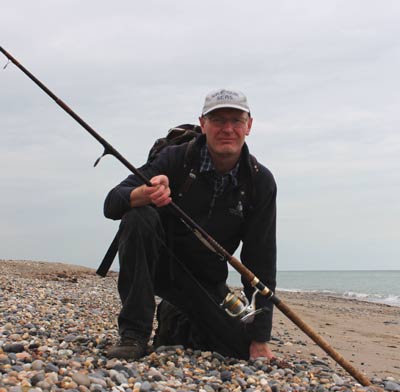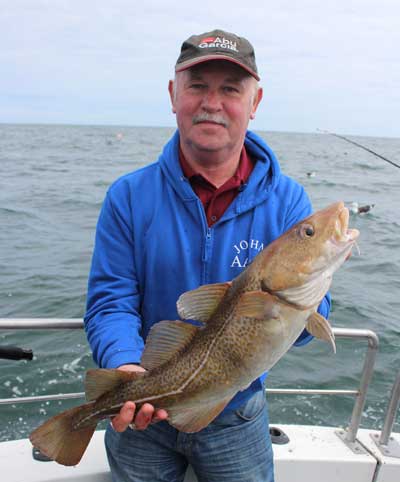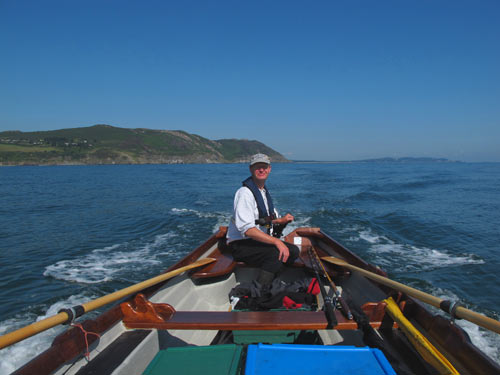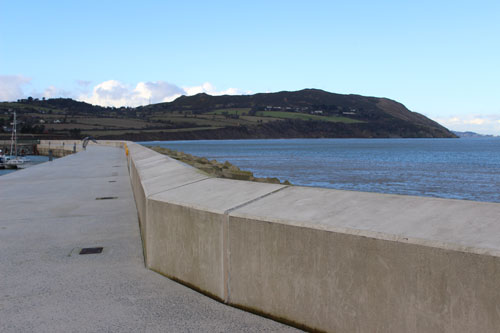The argument to introduce wider stakeholder inclusive and environmentally focused management structures for Ireland’s inshore fisheries is indisputable as this follow on analysis of an earlier study by Ashley Hayden based on Irish Specimen Fish Committee Records for the years 1975 – 2010 covering the inshore waters off north Co. Wicklow clearly shows:
The initial study found that 16 fin fish species swimming in north Wicklow coastal waters traditionally grew to rod and line specimen weight based on ISFC records, by 2010 this figure had declined to four species.
A follow on study by Ashley, recreated below, was undertaken in early 2016 covering the years 2011 – 2015. This research underpinned by the authors extensive historical and experiential local knowledge deepens and broadens the previous studies findings giving some hope for the future but also highlighting a continuous downward trend.
Specimen Fish Ratified for North County Wicklow 2011 – 2015.
Bass – 5.31.kg (11.70.lb) – Wicklow – 10/10/2014 – Keith Marsella – Crab
Bass – 4.62.kg (10.19.lb) – Greystones – 24/06/2012 – Damian Blackwell – Lure
Bull Huss – 7.82.kg (17.25.lb) – Wicklow – 17/07/2013 – Peter Schiffer – Mackerel
Flounder – 1.20.kg (2.65.lb) – Wicklow – 07/10/2014 – Stephen Gibson – Crab
Flounder – 1.12.kg (2.47.lb) – Wicklow – 06/10/2015 – Craig Murphy – Crab
LSD – 1.59.kg (3.50.lb) – Wicklow – 22/08/2013 – Bert McGregor – Mackerel
Thick L. Mullet – 3.27.kg (7.20.lb) – Arklow – 31/07/2014 – Craig Murphy – Bread
Thick L. Mullet – 3.18.kg (7.00.lb) – Wicklow – 01/07/2015 – Des Chew – Bread
Thick L. Mullet – 2.95.kg (6.50.lb) – Wicklow – 25/09/2015 – Ken Garry – Bread
Thick L. Mullet – 2.54.kg (5.60.lb) – Wicklow – 02/07/2015 – Des Chew – Bread
Thick L. Mullet – 2.49.kg (5.50.lb) – Wicklow – 21/06/2015 – Craig Murphy – Bread
Thick L. Mullet – 2.40.kg (5.30.lb) – Wicklow – 17/08/2015 – Des Chew – Bread
Thick L. Mullet – 2.32.kg (5.12.lb) – Wicklow – 20/07/2015 – Dan Smith – Bread
Thick L. Mullet – 2.27.kg (5.00.lb) – Wicklow – 11/08/2015 – Dan Smith – Bread
In total 10 x T. L. Mullet were ratified for County Wicklow in 2014.
In total 7 x T. L. Mullet were ratified for County Wicklow in 2013.
In total 3 x T. L. Mullet were ratified for County Wicklow in 2012.
In total 6 x T. L. Mullet were ratified for County Wicklow in 2011.
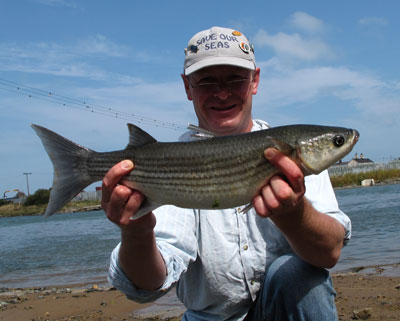
Smooth Hound – 8.62.kg (19.00.lb) – Wicklow – 24/05/2015 – Garech Murphy – Crab.
In total 48 smooth hound were ratified for County Wicklow in 2015 with most being caught off Wicklow town on board Kit Dunne’s Wicklow Boat Charters, a small number being landed in the Arklow area. The smallest hound was 3.04.kg (6.70.lb) caught on the 12th July off Wicklow.
In total 21 smooth hound were ratified for Wicklow in 2014 the largest weighing 6.92.kg (15.25.lb) caught on squid 22/06/2014.
In total 63 smooth hound were ratified for Wicklow in 2013 the largest weighing 7.37.kg (16.25.lb) caught on crab 06/07/2013.
In total 40 smooth hound were ratified for Wicklow in 2012 the largest weighing 6.35.kg (14.00.lb) caught on crab 13/07/2012.
In total 5 smooth hound were ratified for Wicklow in 2011 the largest weighing 6.21.kg (13.69.lb) caught on squid 02/07//2011.

Spur Dogfish – length only – Wicklow – 16/05/2014 – Pat Swan – Mackerel
In total 4 spur dogfish were ratified for Wicklow in 2014 all caught in May.
In total 4 spur dogfish were ratified for Wicklow in 2013 all caught in Oct/Nov.
In total 1 spur dogfish were ratified for Wicklow in 2011 caught in Nov.
T. B. Rockling – 0.86.kg (1.90.lb) – Wicklow – 15/11//2011 – Andrew Boyce – Mackerel
T. B. Rockling – 0.85.kg (1.88.lb) – Wicklow – 19/04/2015 – Belinda Kennedy – Mackerel
T. B. Rockling – 0.82.kg (1.80.lb) – Wicklow – 22/01/2014 – Craig Murphy – Mackerel
T. B. Rockling – 0.82.kg (1.81.lb) – Greystones – 03/04/2015 – Andrew Boyce – Mackerel
T. B. Rockling – 0.81.kg (1.79.lb) – Greystones – 09/03/2015 – Pat Fagan – Mackerel
T. B. Rockling – 0.79.kg (1.75.lb) – Greystones – 15/08/2015 – Andrew Boyce – Mackerel
In total 3 T. B. Rockling were ratified for County Wicklow in 2011.
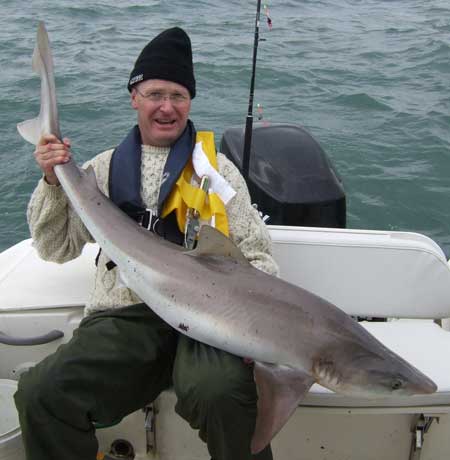
Tope – 22.23.kg (49.00.lb) – Wicklow – 22/07/2015 – Martin Corr – Crab
In total 7 more tope were ratified for Wicklow in 2015 with the smallest fish weighing 19.05.kg (42.00.lb) caught on 12/08/2015.
In total 12 tope were ratified for Wicklow in 2014 the largest weighing 29.03.kg (64.00.lb) caught on mackerel off Greystones 05/07/2014.
In total 21 tope were ratified for Wicklow in 2013 the largest weighing 24.66.kg (54.37.lb) caught on mackerel off Greystones 22/08//2013.
In total 3 tope were ratified for Wicklow in 2012 the largest weighing 27.30.kg (60.19.lb) caught on mackerel off Wicklow 20/10//2012.
In total 1 tope was ratified for Wicklow in 2011 weighing 22.68.kg (50.00.lb) caught on mackerel off Greystones 30/08//2011.
Specimen Size Species Recorded off County Wicklow 2011 – 2015
Number of Species: 9
- Bass x 2
- Bull Huss x 1
- Flounder x 2
- LSD x 1
- Thick Lipped Mullet x 33
- Smooth Hound x 177
- Spur Dogfish x 9
- Three Beard Rockling x 8
- Tope x 44
Relative to the on going study tracking County Wicklow based specimen fish records going back to 1975, the number of specimens recorded post 2010 by species has increased from 4 (bass, tope, smooth hound and grey mullet) to 9 ( the aforementioned species plus bull huss, flounder, LSD, spur dogfish and rockling).
The one newcomer to the list is flounder, the remaining four bull huss, LSD, spurdog and rockling all featuring on previous specimen lists for the area. Are these species making a comeback? Relative to flounder and T. B. rockling the species were always present just that people were not targeting them. An increase in specimen hunting effort where species are targeted in specific locations at specific times of the angling season has resulted in flounder making the list and also an upward movement in T. B. Rockling claims.
The presence of Wicklow Boat Charters post 2011 with subsequent increased effort aimed at so called “rough species” has resulted in a marked increase in smooth hound and tope claims and is definitely a factor in recent claims for specimen bull huss and LSD, both species always present albeit reduced in average size and population.
Spurdog are making a tentative comeback probably due to a current ban on commercial fishing for the species within Scottish waters. However when one considers how prolific this particular species was in spring and again in early winter certainly up to the early 1980’s, the jury is still out as to their ongoing recovery.
Matching Wicklow Boat Charters overall recorded catches for 2014 and 2015 to specimen fish returns for County Wicklow in the same year provides a more accurate picture of the inshore fishery off North County Wicklow.
Wicklow Boat Charters Catch Returns 2014
- Tope – total boated 179 – total specimens ratified 12.
- Smooth hound – total boated 912 – specimens ratified 21.
- Bull huss – total boated 176 – zero specimens ratified.
- Spur dogfish – total boated on a single outing 09/11/2014 = 55 – zero specimens ratified.
Wicklow Boat Charters Catch Returns 2015
- Tope – total boated 185 – specimens ratified for Co. Wicklow 7.
- Smooth hound – total boated 912 – specimens ratified for Co. Wicklow 48.
- Bull huss – total boated 103 – zero specimens ratified for Co. Wicklow.
- Spurdog – total boated 2 – “limited fishing due to bad weather“
Tope and smooth hound populations would appear to be in a reasonably healthy state, on the ground evidence of pups from both species suggesting this status quo should continue. That said, this writer witnessed in 2015 a reduction in average size of smooth hound caught in the Arklow area and the presence of dead smooth hound in 40. kg fish boxes for use as whelk pot bait.
Significantly specimen bull huss and spur dogfish returns are low for the amount of boat man hours directed towards fishing large fish baits in key predator fish locations on board the two vessels operated by Wicklow Boat Charters, with only a few ray encountered (14 in 2014 by Wicklow Boat Charters).
On the plus side a lot of male pack tope are encountered earlier in the summer with larger female tope showing up from August through to October weather permitting.

White fish returns on the north Wicklow fishing grounds though are very poor, the dearth of traditionally targeted edible species other than small grey and tub gurnards, which appear to be quite numerous, reflected in catch returns gleaned from Greystones Ridge Sea Angling Club competition records (boat and shore) for September 2015 & January 2016 respectively, all posted on Facebook.

A 24 cm dab, 26 cm flounder and a 33 cm whiting, all recorded in January 2016 post a shore competition off Five Mile Point with no sizeable codling or coalfish present speaks volumes as to how far biodiversity standards have dropped along the north Wicklow coastline in tandem with bottom mussel bed exploitation, the connection when one knows the fisheries history being indisputable as the above image courtesy of Liam Kane taken at Killoughter in the 1980’s makes clear.
Pre 1980 and the commencement of inshore bottom mussel dredging off County Wicklow 16 species of fish swam in the then abundant north Wicklow waters that grew on or above Irish rod and line specimen weight to include edible species such as cod, plaice, black sole, thornback and blonde ray. Today these species other than the odd juvenile are a distant memory, marine biodiversity reduced wholesale as the dredgers did their work.
Circa 2016 four species, bass, grey mullet, tope and smooth hound (all non quota species) still swim in reasonable numbers and grow to specimen size off Co. Wicklow, while flounder and T. B. rockling exist because they are non commercial and inhabit safe estuary and harbour wall locations respectively. Spurdog, LSD and bull huss though still run the gauntlet of commercial exploitation, a fate which currently threatens the future of the current mainstay Wicklow specimen species bass, grey mullet, tope and smooth hound as commercial interests continue to diversify their catch by fishing down the food chain as prime species become uneconomic due to over exploitation………
Further reading: The Inshore Fishery off North Co. Wicklow from an Angling Perspective.
